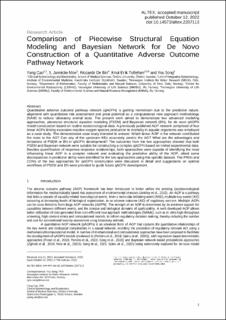| dc.contributor.author | Cao, Yang | |
| dc.contributor.author | Moe, S. Jannicke | |
| dc.contributor.author | De Bin, Riccardo | |
| dc.contributor.author | Tollefsen, Knut-Erik | |
| dc.contributor.author | Song, You | |
| dc.date.accessioned | 2023-03-23T14:32:13Z | |
| dc.date.available | 2023-03-23T14:32:13Z | |
| dc.date.created | 2022-10-14T08:15:02Z | |
| dc.date.issued | 2022 | |
| dc.identifier.citation | Altex. 2022, . | |
| dc.identifier.issn | 1868-596X | |
| dc.identifier.uri | https://hdl.handle.net/11250/3060208 | |
| dc.description.abstract | Quantitative adverse outcome pathway network (qAOPN) is gaining momentum due to the predictive nature, alignment with quantitative risk assessment and great potential as a computational new approach methodology (NAM) to reduce laboratory animal tests. The present work aimed to demonstrate two advanced modeling approaches, piecewise structural equation modeling (PSEM) and Bayesian network (BN), for de novo qAOPN model construction based on routine ecotoxicological data. A previously published AOP network comprised of four linear AOPs linking excessive reactive oxygen species production to mortality in aquatic organisms was employed as a case study. The demonstrative case study intended to answer: Which linear AOP in the network contributed the most to the AO? Can any of the upstream KEs accurately predict the AO? What are the advantages and limitations of PSEM or BN in qAOPN development? The outcomes from the two approaches showed that both PSEM and Bayesian network were suitable for constructing a complex qAOPN based on limited experimental data. Besides quantification of response-response relationships, both approaches were capable of identifying the most influencing linear AOP in a complex network and evaluating the predictive ability of the AOP, albeit some discrepancies in predictive ability were identified for the two approaches using this specific dataset. The PROs and CONs of the two approaches for qAOPN construction were discussed in detail and suggestions on optimal workflows of PSEM and BN were provided to guide future qAOPN development. | |
| dc.language.iso | eng | |
| dc.relation.uri | https://www.altex.org/index.php/altex/article/view/2520 | |
| dc.title | Comparison of structural equation modeling and Bayesian network for de novo construction of a quantitative adverse outcome pathway network | |
| dc.title.alternative | Comparison of structural equation modeling and Bayesian network for de novo construction of a quantitative adverse outcome pathway network | |
| dc.type | Peer reviewed | |
| dc.type | Journal article | |
| dc.description.version | acceptedVersion | |
| dc.source.pagenumber | 11 | |
| dc.source.journal | Altex | |
| dc.identifier.doi | 10.14573/altex.2207113 | |
| dc.identifier.cristin | 2061350 | |
| dc.relation.project | Norges forskningsråd: 160016 | |
| dc.relation.project | Norges forskningsråd: 223268 | |
| dc.relation.project | Norsk institutt for vannforskning: NIVAs Computational Toxicology Program (NCTP) | |
| dc.relation.project | Norges forskningsråd: 301397 | |
| cristin.ispublished | true | |
| cristin.fulltext | postprint | |
| cristin.qualitycode | 1 | |
